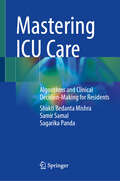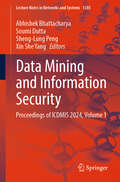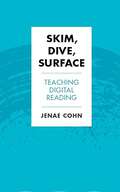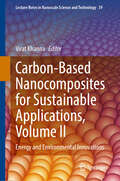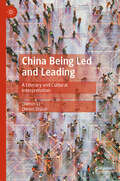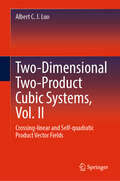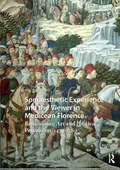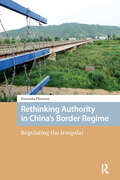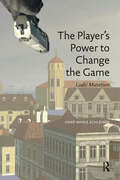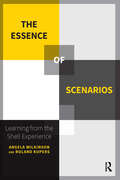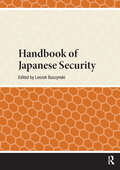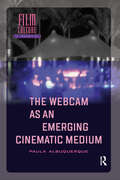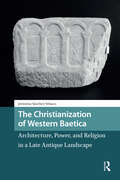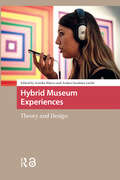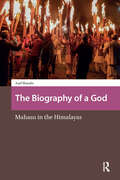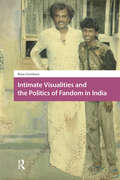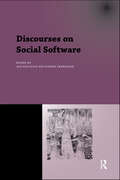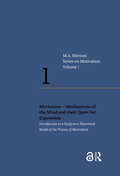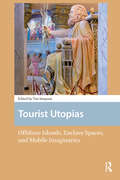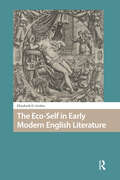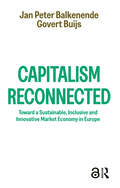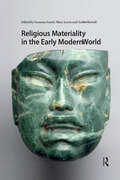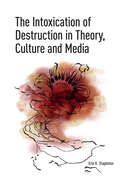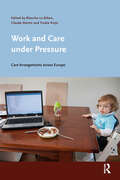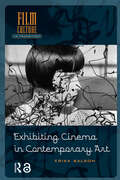- Table View
- List View
Mastering ICU Care: Algorithms and Clinical Decision-Making for Residents
by Shakti Bedanta Mishra Samir Samal Sagarika PandaThis book covers all aspects of ICU care, from diagnostics and treatment modalities to patient management. It features real-world case studies and provides step-by-step guidance on critical care. Additionally, it discusses ICU procedures and algorithms to support clinical decision-making and serves as a concise clinical reference for practitioners. It covers essential topics, such as sepsis, mechanical ventilation, and shock. The book incorporates the latest evidence-based practices and guidelines. The book is aided with ample illustrations, charts, diagrams, and a set of comprehension and review questions to enhance conceptual understanding. The book is relevant for residents of critical care as well as anesthesiology, emergency medicine, internal medicine, and surgery. It is also helpful for nurses, physician assistants, and allied health professionals to better understand clinical decision-making processes in the ICU.
Data Mining and Information Security: Proceedings of ICDMIS 2024, Volume 1 (Lecture Notes in Networks and Systems #1385)
by Sheng-Lung Peng Abhishek Bhattacharya Soumi Dutta Xin She YangThis book features research papers presented at the International Conference on Data Mining and Information Security (ICDMIS 2024) held at Eminent College of Management and Technology (ECMT), West Bengal, India, during October 7–8, 2024. The book is organized in five volumes and includes high-quality research work by academicians and industrial experts in the field of computing and communication, including full-length papers, research-in-progress papers, and case studies related to all the areas of data mining, machine learning, Internet of Things (IoT), and information security.
Skim, Dive, Surface: Teaching Digital Reading
by Jenae CohnStudents are reading on screens more than ever—how can we teach them to be better digital readers? <P> Smartphones, laptops, tablets: college students are reading on-screen all the time, and digital devices shape students’ understanding of and experiences with reading. In higher education, however, teachers rarely consider how digital reading experiences may have an impact on learning abilities, unless they’re lamenting students’ attention spans or the distractions available to students when they’re learning online. <P> Skim, Dive, Surface offers a corrective to these conversations—an invitation to focus not on losses to student learning but on the spectrum of affordances available within digital learning environments. It is designed to help college instructors across the curriculum teach digital reading in their classes, whether they teach face-to-face, fully online, or somewhere in between. Placing research from cognitive psychology, neuroscience, learning science, and composition in dialogue with insight from the scholarship of teaching and learning, Jenae Cohn shows how teachers can better frame, scaffold, and implement effective digital reading assignments. She positions digital reading as part of a cluster of literacies that students should develop in order to communicate effectively in a digital environment.
Carbon-Based Nanocomposites for Sustainable Applications, Volume II: Energy and Environmental Innovations (Lecture Notes in Nanoscale Science and Technology #39)
by Virat KhannaThis book presents readers with a comprehensive discussion on carbon-based nanocomposites and their critical role in addressing global sustainability challenges. By bridging the gap between materials science and real-world applications, this book serves as an invaluable resource for academic researchers, engineers, industry professionals, and advanced students in fields such as materials science, engineering, and environmental studies dealing with the unique properties of carbon-based nanomaterials. It provides a detailed view of carbon-based nanocomposites, offering both foundational knowledge and insights into cutting-edge applications that have the potential to drive sustainable progress in the coming years. This Volume Two, the second of three, covers the environmental and renewable energy applications of carbon-based nanocomposites. It focuses on their role in enhancing the efficiency and durability of renewable energy technologies, such as solar cells, batteries, and supercapacitors. Additionally, it addresses their use in water purification, environmental monitoring, and solar steam evaporation. This volume highlights the potential for carbon-based materials to contribute to cleaner, more efficient energy and environmental solutions.
China Being Led and Leading: A Literary and Cultural Interpretation
by Daniel Braun Zhimin LiThis book unearths a forgotten history of exchange and enlightenment between China and the West, told through vivid examples drawn from the world of poetry, the philosophy of culture and religion, and the realm of international communication. Across chapters that cover an extraordinary range of cultural terrain, from an examination of the parallel expatriate experiences of the British critic and poet William Empson and the Chinese writer Xu Zhimo, to a study of the influence of Christian thought on the evolution of Confucianism, authors Li Zhimin and Daniel Braun rethink the contemporary paradigm of western hegemony and international division that shapes our senses and studies of the East and the West alike, in order to present an image of modern China that is richly hybrid in its blend of cultures, histories, and traditions. This book is immersed in the cultures and literary traditions of China and the West, and written for specialists of the regions and general interest readers alike.
Two-dimensional Two-product Cubic Systems Vol. X: Crossing-linear and Self-quadratic Product Vector Fields
by Albert C. LuoThis book is the tenth of 15 related monographs, discusses product-cubic nonlinear systems with two crossing-linear and self-quadratic products vector fields and the dynamic behaviors and singularity are presented through the first integral manifolds. The equilibrium and flow singularity and bifurcations discussed in this volume are for the appearing and switching bifurcations. The double-saddle equilibriums described are the appearing bifurcations for saddle source and saddle-sink, and for a network of saddles, sink and source. The infinite-equilibriums for the switching bifurcations are also presented, specifically: · Inflection-saddle infinite-equilibriums, · Hyperbolic (hyperbolic-secant)-sink and source infinite-equilibriums · Up-down and down-up saddle infinite-equilibriums, · Inflection-source (sink) infinite-equilibriums.
Somaesthetic Experience and the Viewer in Medicean Florence: Renaissance Art and Political Persuasion, 1459-1580 (Visual and Material Culture, 1300-1700)
by Allie Terry-FritschViewers in the Middle Ages and Renaissance were encouraged to forge connections between their physical and affective states when they experienced works of art. They believed that their bodies served a critical function in coming to know and make sense of the world around them, and intimately engaged themselves with works of art and architecture on a daily basis. This book examines how viewers in Medicean Florence were self-consciously cultivated to enhance their sensory appreciation of works of art and creatively self-fashion through somaesthetics. Mobilized as a technology for the production of knowledge with and through their bodies, viewers contributed to the essential meaning of Renaissance art and, in the process, bound themselves to others. By investigating the framework and practice of somaesthetic experience of works by Benozzo Gozzoli, Donatello, Benedetto Buglioni, Giorgio Vasari, and others in fifteenth- and sixteenth century Florence, the book approaches the viewer as a powerful tool that was used by patrons to shape identity and power in the Renaissance.
Rethinking Authority in China’s Border Regime: Regulating the Irregular (New Mobilities in Asia)
by Franziska PlümmerIn the 21st century, governments around the globe are faced with the question on how to tackle new migratory mobilities. Governments increasingly become aware of irregular immigration and are forced to re-negotiate the dilemma of open but secure borders. Rethinking Authority in China’s Border Regime: Regulating the Irregular investigates the Chinese government’s response to this phenomenon. Hence, this book presents a comprehensive analysis of the Chinese border regime. It explores the regulatory framework of border mobility in China by analysing laws, institutions, and discourses as part of an ethnographic border regime analysis. It argues that the Chinese state deliberately creates ‘zones of exception’ along its border. In these zones, local governments function as ‘scalar managers’ that establish cross-border relations to facilitate cross-border mobility and create local migration systems that build on their own notion of legality by issuing locally valid border documents. The book presents an empirically rich story of how border politics are implemented and theoretically contributes to debates on territoriality and sovereignty as well as to the question of how authority is exerted through border management. Empirically, the analysis builds on two case studies at the Sino-Myanmar and Sino-North Korean borders to illustrate how local practices are embedded in multiscalar mobility regulation including regional organizations such as the Greater Mekong Subregion and the Greater Tumen Initiative.
The Player's Power to Change the Game: Ludic Mutation (MediaMatters)
by Anne-Marie SchleinerIn recent decades, what could be considered a gamification of the world has occurred, as the ties between games and activism, games and war, and games and the city grow ever stronger. In this book, Anne-Marie Schleiner explores a concept she calls 'ludic mutation', a transformative process in which the player, who is expected to engage in the preprogramed interactions of the game and accept its imposed subjective constraints, seizes back some of the power otherwise lost to the game itself. Crucially, this power grab is also relevant beyond the game because players then see the external world as material to be reconfigured, an approach with important ramifications for everything from social activism to contemporary warfare.
The Essence of Scenarios: Learning from the Shell Experience
by Roland Kupers Angela WilkinsonIn 1965, when quantitative planning was much in vogue, Royal Dutch Shell started experimenting with a different way of looking into the future: scenario planning. Shell's practice has now survived for almost half a century and has had a huge influence on how businesses, governments, and other organisations think about and plan for the future. To produce this illuminating study, the authors interviewed almost every living veteran of the Shell scenario planning operation, along with top Shell executives through the years. They identify several principles that both define the process at Shell and help explain how it has thrived for so long. For instance, Shell scenarios are stories, not predictions, and are designed to help break the habit, ingrained in most corporate planning, of assuming that the future will look much like the present.
Handbook of Japanese Security (Handbooks on Japanese Studies)
by Leszek BuszynskiJapan has risen in stature to become an important player not only in the Western Pacific, but the wider Indo-Pacific. From a defeated nation that adopted a pacifist constitution and demilitarization, Japan has been provoked by unwelcomed external events to ensure its security. It has faced a challenging security environment and specific threats that have transformed its domestic politics and given rise to debates about the relevance of its pacifist constitution. North Korea’s nuclear and missile tests, and China’s pressure in the maritime Southwest and the South China Sea, as well as its belligerence over Taiwan, have raised Japanese fears of instability and conflict. Russia’s invasion of Ukraine has alarmed Japan that China would similarly resort to force. This present volume includes chapters by experts, Japanese as well as non-Japanese, who examine these issues and how Japan responds to a more threatening security environment while managing its domestic politics. They discuss the debate about the pacifist constitution, the alliance with the US, Japan’s Quad partners, India and Australia and how Japan moves to maintain and protect a free and open regional and international order from which it has benefited.
The Webcam as an Emerging Cinematic Medium (Film Culture in Transition)
by Paula AlbuquerqueAll the world’s a stage - literally so, given the ubiquitous presence of webcams recording daily life in cities. This footage, allegedly documentary, recreates cities as cinematic environments as people interact with the multitudes of cameras and screens around them. Paula Albuquerque’s original research and experimental films, presented in this groundbreaking book, expose fictionalising elements in archival webcams and explore video surveillance as an urban condition that influences both perceptions of the past and visions of the future.
The Christianization of Western Baetica: Architecture, Power, and Religion in a Late Antique Landscape (Late Antique and Early Medieval Iberia)
by Jeronimo Sanchez VelascoThe province of Baetica, in present-day Spain, was one of the most important areas in the Roman Empire in terms of politics, economics, and culture. And in the late medieval period, it was the centre of a rich and powerful state, the Umayyad Caliphate. But the historical sources on the intervening years are limited, and we lack an accurate understanding of the evolution of the region. In recent years, however, archaeological research has begun to fill the gaps, and this book-built on more than a decade of fieldwork-provides an unprecedented overview of urban and rural development in the period.
Hybrid Museum Experiences: Theory and Design (MediaMatters)
by Annika Waern Anders Sundnes LøvlieSo you're the one getting this gift? Lucky you! Someone who knows you has visited the museum. They searched out things they thought you would care about, and they took photos and left messages for you., This is the welcoming message for the Gift app, designed to create a very personal museum visit. Hybrid Museum Experiences use new technologies to augment, expand or alter the physical experience of visiting the museum. They are designed to be experienced in close relation to the physical space and exhibit. In this book we discuss three forms of hybridity in museum experiences: Incorporating the digital and the physical, creating social, yet personal and intimate experiences, and exploring ways to balance visitor participation and museum curation. This book reports on a 3-year cross-disciplinary research project in which artists, design researchers and museum professionals have collaborated to create technology-mediated experiences that merge with the museum environment.
The Biography of a God: Mahasu in the Himalayas (Religion and Society in Asia)
by Asaf SharabiMahasu is the joint name of four gods whose influence is widespread throughout the Indian states of Himachal Pradesh and Uttarakhand. Like other deities in the Western Himalayas, they are regarded as royal gods who rule over territories and people. This book traces changes in faith and practices surrounding the Mahasu brothers, and shows how the locals understand these changes by emphasizing the dominant role of humans in the decisions of the gods. The locals are also constantly testing the authenticity of the human mediumship. Thus, the book presents the claim that the gap between local conceptions of divinity and the perceptions of anthropologists regarding gods may be narrower than we think. The Biography of a God: Mahasu in the Himalayas is based on ethnographic research, resulting in an important contribution to the study of Indian village deities, Himalayan Hinduism, lived Hinduism, and the anthropology of religion.
Intimate Visualities and the Politics of Fandom in India (Asian Visual Cultures)
by Roos GerritsenIn Intimate Visualities and the Politics of Fandom in India, Gerritsen explores the circulation of images of a movie star named Rajinikanth. Cities and towns in the south Indian state Tamil Nadu are consistently ornamented with huge billboards, murals and myriad posters featuring political leaders as well as movie stars. A selective part of these images is put up by their fan clubs. Tamil movie fans typically manifest themselves by putting up images of their star in public spaces and by generating a plethora of images in their homes. Gerritsen argues that these images are a crucial part of the everyday affective modes of engagement with family members and film stars but they are also symbolizing the political realm in which fans situate themselves. At the same time, Gerritsen shows how these image productions seem to concur with other visual regimes articulated in government restrictions, world class imaginaries and upper class moralities as presented on India's urban streets.
Discourses on Social Software (Texts in Logic and Games)
by Rineke Verbrugge Jan Van EijckCan computer scientists contribute to the solution of societal problems? Can logic help to model social interactions? Are there recipes for making groups with diverging preferences arrive at reasonable decisions? Why is common knowledge important for social interaction? Does the rational pursuit of individual interests put the public interest in danger, and if so, why? Discourses on Social Software sheds light on these and similar questions. This book offers the reader an ideal introduction to the exciting new field of social software. It shows in detail the many ways in which the seemingly abstract sciences of logic and computer science can be put to use to analyse and solve contemporary social problems.The unusual format of a series of discussions among a logician, a computer scientist, a philosopher and some researchers from other disciplines encourages the reader to develop his own point of view. The only requirements for reading this book are a nodding familiarity with logic, a curious mind, and a taste for spicy debate.
Motivation – Mechanisms of the Mind and their Quest for Expression: Introduction to a Study on a Theoretical Model of the Process of Motivation (Series on Motivation)
by Menno A. MennesThis volume presents a first introduction to a thought-provoking Model of Motivation developed by Menno Mennes over a period of almost thirty years. The Model of Motivation in its approach presents a radical departure from everything that has appeared so far in literature on the subject. And yet, it provides a surprisingly detailed account of how motivation works, which appears to be supported by findings from theories and research from current literature. In an unparalleled analysis, the Model seamlessly integrates these major theories into a consistent comprehensive approach to motivation, explaining not only the essentials of each theory, but also providing explanations for controversies that have hitherto remained largely unresolved. Motivation appears to be an 'inner dialogue', a stepwise, partly cyclical Process in which we deal with our surroundings that often interfere in our ambitions, our wishes and desires. Deep personal insights into those 'Mechanisms of the Mind' reveal implications that may lead to a fundamental, new understanding of the origins of many disturbing issues we witness in present-day society, including neglect and denial, intolerance, discord and polarization.
Tourist Utopias: Offshore Islands, Enclave Spaces, and Mobile Imaginaries (New Mobilities in Asia)
by Tim SimpsonReleased on the 500-year anniversary of the publication of Sir Thomas More's Utopia, this volume seeks to adapt and apply More's fecund imagination to the contemporary leisure landscape. The contributors to this volume theorize and analyze a variety of 'tourist utopias' - a nascent socio-spatial form crucial to a post-industrial global economy. From Disney World to Dubai, 'Middle Earth' to Marina Bay, Macau to Abu Dhabi, these sites share common characteristics that include their respective status as 'spaces of exception' entrepreneurial governance regimes that rely on cooperation among state and non-state actors; transient, multinational populations; immaterial and affective forms of labor and consumption; superlative and iconic architecture; and economies devoted to such leisure activities as shopping, gambling, and spectacle. These locales are not only popular destinations for migrant workers and mobile tourists from around the globe, but also serve as cultural laboratories for testing new formats and protocols of an emergent post-Fordist form-of-life.
The Eco-Self in Early Modern English Literature (Environmental Humanities in Pre-modern Cultures)
by Elizabeth GruberThe Eco-Self in Early Modern English Literature tracks an important shift in early modern conceptions of selfhood, arguing that the period hosted the birth of a new subset of the human, the eco-self, which melds a deeply introspective turn with an abiding sense of humans’ embedment in the world. A confluence of cultural factors produced the relevant changes. Of paramount significance was the rapid spread of literacy in England and across Europe: reading transformed the relationship between self and world, retooled moral reasoning, and even altered human anatomy. This book pursues the salutary possibilities, including the ecological benefits, of this redesigned self by advancing fresh readings of texts by William Shakespeare, Christopher Marlowe, John Webster, and Margaret Cavendish. The eco-self offers certain refinements to ecological theory by renewing appreciation for the rational, deliberative functions that distinguish humans from other species.
Capitalism Reconnected: Toward a Sustainable, Inclusive and Innovative Market Economy in Europe
by Jan Peter Balkenende Govert BuijsCapitalism has gone astray. Today we face ecological exhaustion, persistent inequality, financialization, stress on communities, short-termism, and new power concentrations. An avalanche of new economic thinking and a reorientation of European values show the way toward a different economy. A new perspective is necessary if we want to implement the Sustainable Development Goals and if we consider our planet as 'Our Common Home,' for present and future generations. This book argues that European economies should be the initiators of a global transition toward a sustainable and inclusive world economy. Together, amid severe geopolitical and geoeconomic challenges, they need to develop their own perspective on what a good economy really is, in distinction to Chinese state capitalism and American big business capitalism. Crucially, this requires the rediscovery of key European values, a coherent view on responsible capitalism, and a new self-awareness as a global player for the Common Good in today's and tomorrow's world.
Religious Materiality in the Early Modern World (Visual and Material Culture, 1300-1700)
by Andrew Morrall Mary Laven Suzanna IvaničThis collection of essays offers a comparative perspective on religious materiality across the early modern world. Setting out from the premise that artefacts can provide material evidence of the nature of early modern religious practices and beliefs, the volume tests and challenges conventional narratives of change based on textual sources. Religious Materiality in the Early Modern World brings together scholars of Catholic, Protestant, Jewish, Islamic and Buddhist practices from a range of fields, including history, art history, museum curatorship and social anthropology. The result is an unprecedented account of the wealth and diversity of devotional objects and environments, with a strong emphasis on cultural encounters, connections and exchanges.
The Intoxication of Destruction in Theory, Culture and Media: A Philosophy of Expenditure after Georges Bataille
by Erin K. StapletonThis book examines the desire for, and intoxication with destruction as it appears in cultural objects and representation, arguing that all cultural and aesthetic value is fundamentally predicated on its own fragility, as well as the living transience of those who make and encounter it. Beginning with a philosophy of expenditure after Georges Bataille, each chapter maps different operations of destruction in media and culture. These operations are expressed and located in representations of human extinction and explosive architecture, in execution and in eroticism, and in media and digital archives, which constitute a further destabilization of the notion of destruction in the dynamic between aspirational immortality and material volatility embedded in the archival systems of digital cultures.
Work and Care under Pressure: Care Arrangements across Europe (Care & Welfare)
by Claude Martin Trudie Knijn Blanche Le BihanIn many European countries tensions have arisen between the demands of the labor market and the caregiving responsibilities workers must fulfill at home. Examining these tensions, Work and Care under Pressure focuses on two groups of people who must juggle work and caregiving: parents of young children who work nonstandard hours and working adults who care for older parents. Based on empirical evidence from six European countries, this volume sheds light on the social effects of national policies and the choices made by caregivers. It is an essential resource for researchers, scholars, and policy makers interested in social policy.
Exhibiting Cinema in Contemporary Art (Film Culture in Transition)
by Erika BalsomWhether it involves remaking an old Hollywood movie, projecting a quiet 16mm film, or constructing a bombastic multi-screen environment, cinema now takes place not just in the movie theatre and the home, but also in the art gallery and the museum. The author of this engaging study takes stock of this development, offering an in-depth inquiry into its genesis, its defining features, and the ramifications it has for art and cinema alike. Through the lens of contemporary art history, she examines cinema studies’ great disciplinary obsession – namely, what cinema was, is, and will become in a digital future.
